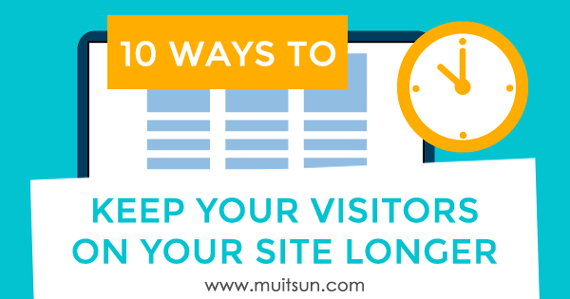As entrepreneurs we all know the importance of having a professional website and getting regular traffic. But getting traffic is only half the battle. The real challenge is making your visitors stay on your website long enough to find out more about what you have to offer and, even better, come back for more.
So, what makes people click the back button? What can you do to make your visitors stay beyond the first few seconds?
1. Be Clear About What You Do.
When a visitor comes to your site, is it immediately clear what your website is about? Your visitors need to know whether your website is relevant to them. If they can't figure out what you do, they'll quickly move on to the next site.
Don't forget, your visitors are looking at your site for a reason. They are looking for something to fulfill a need. Your job is to help them find the information they need, quickly and clearly.
2. Know Your Target Audience.
Everything about your website, from its colour scheme, font sizes to its contents and tone of voice, needs to speak to your target market.
If your website tries to speak to everyone on the planet, you will end up not engaging anyone in particular. Don't be afraid to really zoom in and be specific about the ideal client you want to serve. In fact, the more specific you can be the better.
3. Simplicity, Not Cleverness.
Your website may have clever interactivity or state-of-the-art animation, but if it doesn't engage your visitors and make them stay beyond the initial few seconds, you will have lost them forever.
4. Speed up Your Site.
We live in a fast-pace world. People are busy. Your website needs to load quickly or your visitors will go somewhere else. Nobody has the patience to wait for a slow web page to load, especially if they're browsing your site on a mobile device.
Do a website spring clean to make sure nothing is slowing your site down. If your site is slow and you can't figure out why, hire professional help.
5. Look Professional.
Make sure your site looks reputable, trustworthy and not spammy. There's nothing wrong with a DIY site if you have some basic design skills and an eye for what looks good. There's a whole world of difference between not wanting to invest in a good website and knowing that you can do a pretty good job yourself.
The problem is you can often tell a DIY site from a mile away. The bottom line is, why should your visitors invest in your products and services if your website screams "I don't want to invest in my own company?"
Understandably, solo entrepreneurs often have a tight budget when starting up. However, a professional website, good photography and copywriting are some of the essential investments you should not skimp on.
6. Check Grammar and Spellings.
Typos and poor grammar send out the wrong signals to your visitors. This is all about trust: if people are going to part with their hard-earned cash, they need to trust your business. Spelling errors and grammatical mistakes make your company appear less trustworthy.
A recent study revealed that over half of the participants would not use a company that had obvious grammatical or spelling mistakes on its website, saying that they wouldn't trust the company to provide a good quality service.
7. Fresh Contents.
If the last entry in your blog is a year old, or if the latest "news" is from 2012, it's time to dust the cobwebs or your visitors will assume your business is no longer current. Make sure you keep your website up to date. Nobody wants to do business with a company that appears old and dusty. Having fresh contents also tells search engines like Google that your site is still alive.
8. Make it User Friendly.
Make sure your website is easy to navigate and your visitors can find the information they need quickly without having to drill down too many levels.
Use images and white space to provide a layout that's easy on the eye. Too much text will send your readers to sleep.
Use categories and your website's navigation hierarchy to group contents in a logical way.
Make it easy for your visitors to contact you or they'll take their business elsewhere.
9. Go Easy on the Ads.
Displaying too many advertisements on your site can make it look spammy and distracting, making it difficult for your visitors to navigate around your site. Ads which contain a lot of movement are particularly bad. Having too many ads on your site also makes it slower to load.
Monetising your site is a good idea, but do be considerate to your visitors. Spend some time to think about where to strategically place the ads.
10. Clear Call to Action.
Don't assume your visitors will know automatically what to do. You need to tell them. Want them to sign up to your newsletter? Say so with a clear call-to-action button. Give them an incentive to do so. Want them to ask for a quote? Tell them where to go to fill in the form, or display your telephone number clearly. Want them to schedule a free consultation call? Provide the link to book a call with you.
Engaged Visitors = Buyers
Keeping your website visitors engaged is one of the most important things for website owners. Engaged visitors are more likely to buy your products, purchase your services and sign up to your mailing lists. They will also remember you and come back for more in the future.
~ ~ ~
You can find Mui at www.muitsun.com creating beautiful websites for female entrepreneurs and helping them shine.

